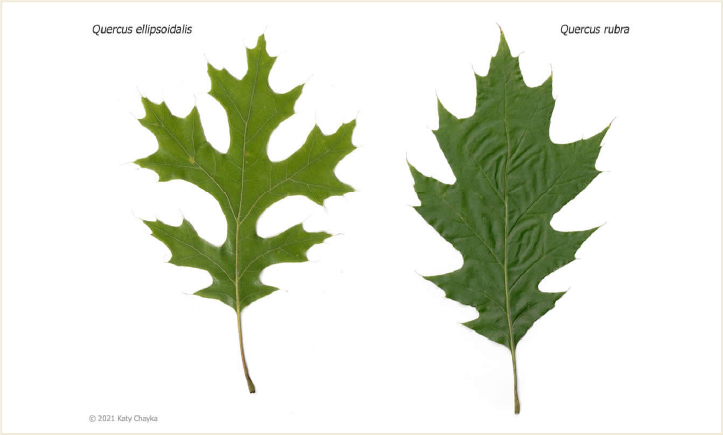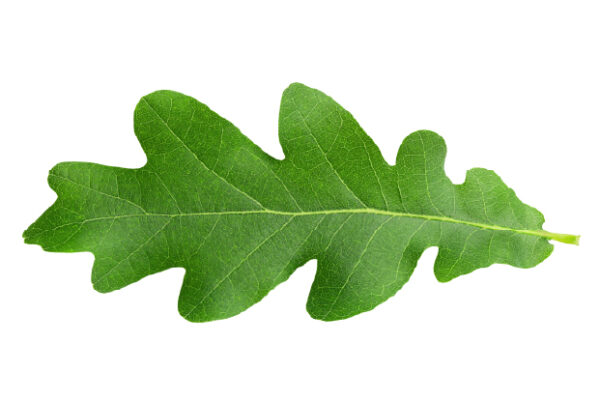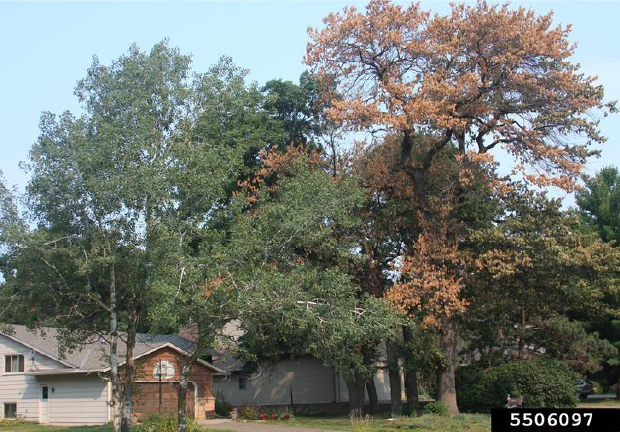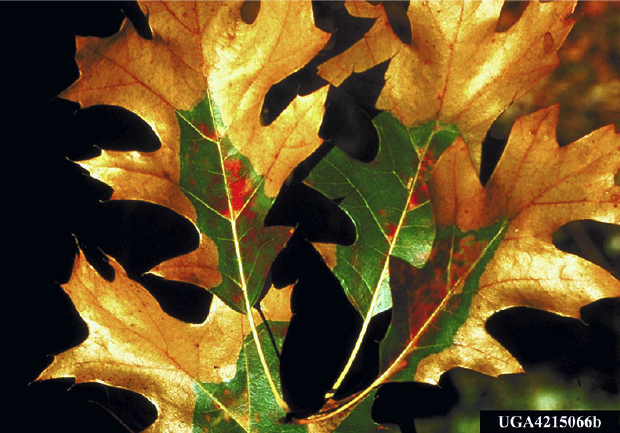
In Minnesota, there are two groups of Quercus, the genus for oak trees: red and white oak.
Red oak trees are identifiable by their pointed lobes. These trees include red oaks and northern pin oaks. The lobes on a red oak go halfway in, whereas pin oak lobes go almost 80% of the way in.
White oaks, on the other hand, have rounded lobes. These trees include white oak, swamp white oak, and bur oaks.


The structural differences between red and white oak affect how each respond to oak wilt. The internal structure consists of a group of hollow vessels, which resemble a handful of straws. In red oaks, these vessels are long and don’t have any blockages or barricades. The vessels are shorter in white oaks and have checkpoints or “lock and dam” systems up the tree.
It’s important to note that the fungus traveling through the vessels isn’t the cause of tree death. Instead, it is the tree’s response to the fungus. This response could be compared to an allergic reaction, as the tree uses its usual response to wounds to limit the fungus spread.
When oak wilt gets into red oak, the tree has no natural structural impediments to the spread of the fungus, whereas white oaks do. If a red oak gets oak wilt, it will die very quickly, usually in weeks, and there’s very little we can do to stop it.
Oak wilt can kill a white oak tree, but it can take a while. White oaks can have oak wilt for years, and while it will cause problems, the tree can actively compartmentalize the fungus. So, it’s easier to treat a white oak for oak wilt.
Like Dutch elm disease, oak wilt moves through tree root grafts. Root graft transmission is a significant concern, as every tree in that graft will suffer from oak wilt if one becomes affected. If a tree has oak wilt, there aren’t many ways to stop it from getting into adjacent trees. One solution is to use a “vibratory plow,” a long, narrow, knife-like blade that cuts through root grafts to break them up. This is necessary when people have a lot of land or acreage because it could save a lot of trees.
Oak wilt is also spread by oak picnic beetles. These pests feed on sap that oozes out of tree wounds from internal pressure. As these beetles are attracted to tree wounds, they are common after events that create these wounds, such as storm damage or pruning. This is why you don’t prune oak trees in the spring or summer. Even if you’re only pruning deadwood, you will still create wounds of live tissue.
Red oaks spring after they die. On the tree’s trunk, there will be spore mats from the fungus. As the mat thickens and the bark dries, it cracks the bark, and the spore mat produces pheromones that attract the beetles. Beetles feed on spore mats and pick up spores, then feed on broken twigs and deposit spores. They only travel a short distance, so you only need to look for signs of oak wilt within a mile or two of the tree.


The “safe” period for oaks is from mid-November to late March or early April. This period begins when it’s cold enough to ensure no beetle activity. After this, oaks go into a high-risk period from late March to mid-July. July to November is the low-risk period, where there’s a chance that a beetle picks up fungus from a tree and not a spore mat.
The specific dates differ every year, depending on the weather. Watch for updates from the University of Minnesota, which tracks beetle activity and issues alert periods.
The treatment for oak wilt is similar to that for Dutch elm disease. There are two reasons to treat oak wilt: therapeutic and preventative. Because of the structural differences, therapeutic treatment is usually only warranted for white oak trees. However, treatment is invasive and can damage the tree.
There are also preventative treatment options. Preventive treatment is sometimes warranted for red oaks, but only in single trees or small groups of trees if there are no root grafts to other trees. White oak trees aren’t usually treated preventatively because of the potential damage to the tree.
The way that oak wilt manifests in white oak trees can look like a lot of other things. Before performing any preventative treatment, we take samples and send them to the lab at the University of Minnesota. The lab will then run a panel of tests. It’s easy to get false negatives if you don’t take a sample of the entire spectrum. So, if you bring in a thoroughly wilted or fully green branch, it will return a negative test result. In the case of Dutch elm disease, you must treat the tree and prune it. With white oaks that have oak wilt, it may be advantageous to prune the tissue, but if the infection is widespread, it may be best to wait.
All in all, it’s essential to take care of the tree so that it can take care of itself. If you suspect oak wilt in your oak trees, contact our team of expert arborists.
From questions to estimate requests, contact us about your residential or commercial project.